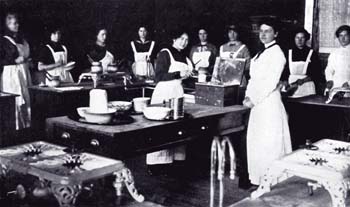
College home economics class, from the 1913 Parnassus.
The accompanying article quaintly describes the home-ec
classroom from a decidedly masculine viewpoint: “Whence
come these delicious odors?” Despite this half-mocking
attitude, the department persisted for 45 years, incorporating
cutting-edge social science into its coursework.
Even in a post-feminist world, the home economics discipline remains strong, not just in high schools, but at the university level: Kansas State’s “human ecology” major includes classes in nutrition, family life and interior design.
And back in 1960, the University of Wichita’s decision to close its home economics department had more to do with ordinary economics than with women’s changing roles.
Domestic science was one of the first courses taught at Fairmount College. According to John Rydjord, plans for “the study of not only foods but of sanitation, care of the body, sewing, dressmaking and interior decoration” were in place before 1900.
While the first course, taught by Harriet Vandivert, was dropped for lack of funds, in 1912 Grace Wilkie was hired to head the department. The classes were to be “strictly scientific,” with chemistry as a prerequisite.
That year’s Parnassus reporter had a less serious attitude, traveling to “the realm of this fair virgin (presumably Wilkie) and her fortunate maidens” in their “modern laboratory,” where they created ambrosial delights for lucky men.
Over the life of the department, subjects offered were diverse, with textiles, home nursing and nutrition taking their place alongside more traditional courses such as food preparation and child care and development.
During the two world wars, home-ec students and professors lent their support to the nation’s armed forces: Wilkie taught a 1917 class in caring for wounded soldiers and prisoners of war, and members of the 1943 Home Economics Club made Red Cross service kits and mended ROTC uniforms.
Under the guidance of professors such as Wilkie, Lolie Smith and Victoria Rockwood, the department spent 45 years educating women for work in the home. Many students combined home ec with other “female” fields of study (education or secretarial training, for instance), although a 1955 study found that 87 percent of graduates were homemakers.
Cutting-edge concepts in sociology and psychology were integrated into the study of relationships with husbands and children and included such goals as “understand(ing) deeply the values and needs and wants of others while at the same time (being) sure of our own values and respect(ing) both our own values and theirs.”
A 1950s home-ec department “creed” by Ellen H. Richards sounds downright progressive, aiming for “the ideal home life for today unhampered by the traditions of the past.”
Despite these modern innovations, enrollment in home economics was falling throughout mid-century. In an effort to boost interest, the university completed a high-tech facility in 1957. The building, which opened with a gala called “Futurama,” was all it promised, with ground-floor space for modern kitchens and classrooms — but it failed to attract the needed numbers of students.
Due to this downturn, which President Harry Corbin saw as a nationwide trend, and the cost of each home economics credit hour (twice the university average), the department was closed less than three years after moving to its new offices.
The closing required home-ec majors to take courses at Friends University for transfer credit, and the building was used by the political science department before its eventual demolition.
For many alumnae, WU’s loss of home ec was the premature end of an era. Some blamed instructor Katharine Van Keuren ’22’s reportedly difficult personality — although Corbin defended her, saying: “We don’t feel that any one instructor has seriously affected the students.”
Others lambasted Corbin for underestimating — as men seemed wont to do — the importance of a well-regulated home life. As Joyce (Allison) Nichols ’51 wrote, “After all, our families are our most important product in this age of space and cold war.”





